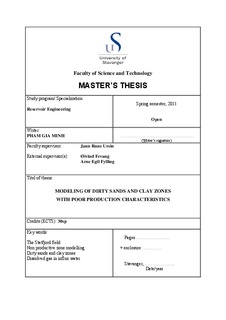| dc.contributor.author | Pham, Minh Gia | |
| dc.date.accessioned | 2011-10-28T14:21:24Z | |
| dc.date.available | 2011-10-28T14:21:24Z | |
| dc.date.issued | 2011 | |
| dc.identifier.uri | http://hdl.handle.net/11250/183323 | |
| dc.description | Master's thesis in Petroleum engineering | no_NO |
| dc.description.abstract | The Statfjord field is one of the oldest and largest oil and gas producing fields on the Norwegian continental shelf. It is currently at its late life production period with pressure depletion as the main production mechanism. Gas released from the residual oil contributes a large portion to the field reserves. At this period of production, all sources of pressure support are important and should be included in modeling of pressure drop in reservoir.
Non productive zones, which contain "dirty sand" and clay, are traditionally not included in numerical reservoir simulation models as they are believed to have a negligible impact on the production performance. However, in this project, when the pressure reduction is large and over a long time, the non productive zones can act as an external pressure support by produce water into the reservoir. Additionally, the gas dissolved in such water will be released as pressure of the reservoir drops. The gas is liberated under the form of small bubbles and the bubbles are believed to be immobile – they block the pore and act as a factor of pore volume reduction. This helps increasing effective compressibility of the formation. Both of the mentioned effects can contribute significantly to total reservoir pressure drop. The objective of this thesis is to evaluate the pressure contribution from non productive zone to total pressure drop by calculating induced water volume from the zone into reservoir and to develop methods for including the impact of such zones in conventional reservoir simulation models.
The thesis involves in building reservoir simulation models with basic fluid and rock properties data from Brent formation of Statfjord field and different combinations of parameters of non productive zone permeability, thickness, compressibility, field depletion time and reservoir pressure drop to evaluate the correlations between those parameters with induced water volume from the zone into reservoir. Reservoir simulator Eclipse is utilized for simulating the flow of fluids and pressure inside the zone and reservoir. For the impact of dissolved gas in water liberation on effective compressibility of rock, ROCKTAB keyword, which traditionally used for rock compaction/expansion scenario, is utilized.
It has been observed in the simulation results that for a specific combination of parameters for non productive zone, there is a value of thickness such that no matter how thicker than that value the non productive zone is, the volume of induced water does not change dramatically. For a specific zone, optimum grids thickness should be used in building simulation models to save time and resources for having to run with finer grid sizes. Grids thickness distribution for the non productive zone seems not to have a large impact on the simulating results.
Different correlating equations between induced water volume and the other parameters have been found for the cases where the thickness of non productive zone is higher than the effective value and that of non productive zone less than the effective value. The equations may generally be used to estimate induced water volume for other formation rather than for Brent formation only.
ROCKTAB keyword is useful when being used to simulate the impact from dissolved gas releasing. The result data fit well with the data calculated from correlating equation mentioned above.
This thesis is merely a primary study on the matter. More works on running simulation models which integrate combinations of parameters should be carried out in order to confirm the obtained correlating equations as well as the application of such equations on general formation cases. | no_NO |
| dc.language.iso | eng | no_NO |
| dc.publisher | University of Stavanger, Norway | no_NO |
| dc.relation.ispartofseries | Masteroppgave/UIS-TN-IPT/2011; | |
| dc.subject | petroleumsteknologi | no_NO |
| dc.subject | reservoarteknologi | no_NO |
| dc.subject | the statfjord field | no_NO |
| dc.subject | non productive zone modelling | no_NO |
| dc.subject | dirty sands | no_NO |
| dc.subject | dissolved gas in influx water | no_NO |
| dc.subject | clay zones | no_NO |
| dc.title | Modeling of dirty sands and clay zones with poor production characteristics | no_NO |
| dc.type | Master thesis | no_NO |
| dc.subject.nsi | VDP::Technology: 500::Rock and petroleum disciplines: 510::Petroleum engineering: 512 | no_NO |
